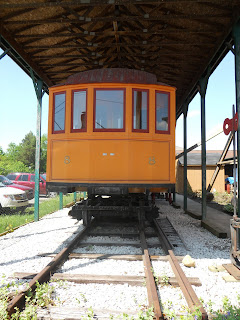 The 309 and 319 operated on Saturday and Monday (wood car operations Sunday were canceled due to rain); I was only there for Monday so hopefully my father can post photos from Saturday. Memorial Day turned out to be a beautiful, virtually cloudless day, with temperatures and humidity both in the 90's but a stiff breeze that helped out a lot. The cars ran uneventfully all day and had good passenger loads for every trip.
The 309 and 319 operated on Saturday and Monday (wood car operations Sunday were canceled due to rain); I was only there for Monday so hopefully my father can post photos from Saturday. Memorial Day turned out to be a beautiful, virtually cloudless day, with temperatures and humidity both in the 90's but a stiff breeze that helped out a lot. The cars ran uneventfully all day and had good passenger loads for every trip.
The crew was (L-R): Greg Ceurvorst, motorman; Randy Hicks, trainman; Frank Hicks, conductor.

At 12:30 there was a very nice memorial ceremony behind the East Union depot which was led by one of the reenators who portrays a chaplain in the 82nd Airborne and is a deacon in real life. His remarks were followed by the playing of "Taps."
 Bet you didn't know we had a WWII hospital car, eh? This is actually our Green Bay & Western coach, which in recent years has worn a light yellow livery applied by its previous owner, the Marquette & Huron Mountain. Lately it has seen use as part of the "Train of Terror." For the WWII event it was given a quick coat of olive drab. It may not be authentic, but at least it's close to Pullman green! This car is an "honorable mention" Hicks car, built by ACF to match cars the GB&W already owned that had been built by Hicks Locomotive & Car Works.
Bet you didn't know we had a WWII hospital car, eh? This is actually our Green Bay & Western coach, which in recent years has worn a light yellow livery applied by its previous owner, the Marquette & Huron Mountain. Lately it has seen use as part of the "Train of Terror." For the WWII event it was given a quick coat of olive drab. It may not be authentic, but at least it's close to Pullman green! This car is an "honorable mention" Hicks car, built by ACF to match cars the GB&W already owned that had been built by Hicks Locomotive & Car Works.
In the afternoon the always-popular Veracruz open car came out and made a number of trips. Frank Sirinek and his crew have refinished nearly all of the car's seats and it is a tremendous improvement.














































